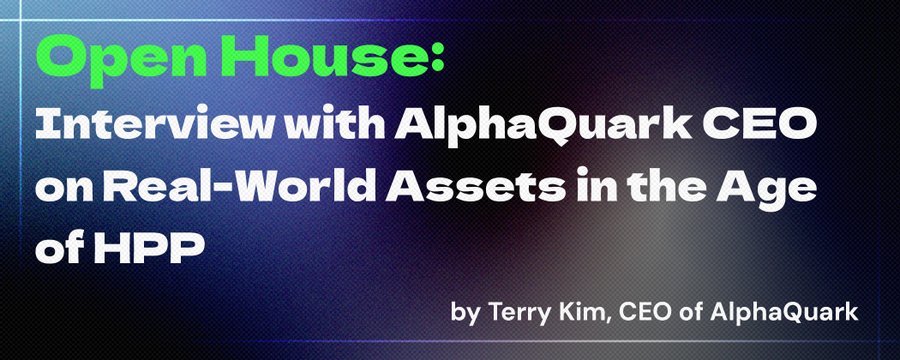https://twitter.com/aergo_io/status/1924800413368476005
As part of our ongoing series highlighting key contributors to the House Party Protocol (HPP), we spoke with Terry Kim, CEO of AlphaQuark, a core partner in the HPP ecosystem. AlphaQuark has positioned itself at the intersection of real-world assets (RWA), NFTs, and smart financial infrastructure, delivering tools to bring traditional asset valuation into the on-chain world. In this interview, Terry outlines how AlphaQuark is evolving alongside HPP, and why L2 scalability, AI integration, and cross-chain connectivity are unlocking the next frontier for tokenized assets.
Q1: How would you describe AlphaQuark’s role within the HPP ecosystem? Terry Kim: AlphaQuark was built with a clear mission: to bridge real-world asset value into the blockchain economy. Within HPP, we act as the asset intelligence layer. We’re building not only tokenization systems but also pricing models, data integration tools, and evaluation protocols that let real-world assets interface with smart contracts. The result is a deeper connection between tangible value and programmable finance. In many ways, we’re the “what it’s worth” layer in an ecosystem that’s about verifying, trading, and applying that value.
Q2: How does AlphaQuark benefit from the transition to HPP Layer 2? Terry Kim: L2 opens up much-needed bandwidth for complex asset logic. Valuation data changes frequently. Compliance checks, liquidity modeling, and even AI-based risk assessments all require more than static smart contracts. HPP Layer 2 gives us the ability to deploy more advanced contract logic and integrate AI agents without bottlenecking performance. It’s the infrastructure upgrade we needed to take AlphaQuark from issuing assets to operating living, evolving asset networks.
Q3: What is the possible shift for AlphaQuark after the launch of HPP? Terry Kim: HPP marks a major turning point for us. We’ve always focused on building infrastructure for decentralized value, and with HPP Layer 2, we can now do that at scale and with far more sophistication. We’re not pivoting from traditional finance — we’re fully committing to building natively within Web3. This means optimizing for composability, data streaming, and AI-native integrations rather than relying on legacy compatibility. It’s a natural evolution of where we’ve been headed.
Q4: What makes AlphaQuark uniquely suited to contribute to a unified data and AI-first ecosystem like HPP? Terry Kim: We’re already working with datasets that traditional DeFi protocols can’t handle: appraisal records, legal certificates, and real-world transaction history. Bringing these into the HPP ecosystem means integrating them with AI agents and verifiers. It also means building a common language for “what is valuable” across both human institutions and autonomous protocols. That’s a challenge we’re trying to solve.
Q5: What are some specific industries where AlphaQuark’s RWA infrastructure is seeing the most traction? Terry Kim: Real estate is a big one, not just tokenizing properties, but bringing appraisal logic, loan terms, and insurance factors on-chain. We’re also seeing interest from insurance platforms, IP marketplaces, and even ESG data providers. They all need trust-minimized ways to package and transfer value. That’s what we will provide.
Q6: How is AlphaQuark leveraging smart contracts for asset valuation, and how will this evolve with L2? Terry Kim: Right now, we use smart contracts to define valuation rules and create standardized RWA token formats. With HPP L2, we’ll be able to dynamically update those contracts with AI-supplied data. Imagine smart contracts that evolve based on real-time economic indicators, appraisal updates, or audit streams. We also see tremendous potential in AI-powered oracles, which can serve as a dynamic verification and data delivery layer for valuation logic. This will give RWAs a much more intelligent and adaptive pricing mechanism.
Q7: How do you approach data validation and compliance when bridging off-chain assets on-chain? Terry Kim: We apply a mix of off-chain attestations, oracles, and verified issuers. The HPP ecosystem dramatically improves this with W3DB’s Verification-as-a-Service and Booost’s identity frameworks. That’s the beauty of an integrated ecosystem: we don’t have to build everything ourselves—we just connect to other verified components.
Q8: How do you see AlphaQuark integrating AI and autonomous agents? Terry Kim: In two ways. First, AI will help process valuation data faster, especially in volatile or emerging markets. Second, autonomous agents can execute strategies like rebalancing asset portfolios, flagging suspicious price anomalies, or even initiating compliance actions. The endgame is programmable value, and AI is the logic layer that makes that real.
Q10: In 3–5 years, what role do you hope AlphaQuark will play in the future of on-chain finance? Terry Kim: I hope we become the trusted layer for pricing and packaging real-world value. Whether it’s a digital twin of an asset, a structured NFT portfolio, or an AI-driven risk model, I want AlphaQuark to be the valuation oracle that DeFi and TradFi both trust. That’s the long game.
We’re the “what it’s worth” layer in an ecosystem that involves verifying, trading, and applying that value.
